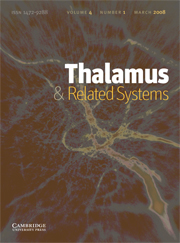Article contents
Developmental decrease in REM sleep: the shift to kainate receptor regulation
Published online by Cambridge University Press: 18 April 2006
Abstract
We found a shift in the responsiveness of pedunculopontine neurons from N-methyl-D-aspartic acid (NMDA) to kainic acid (KA) regulation around 15 days of age. While rapid eye movement (REM) sleep in humans decreases from 50 to 15% of sleep time between birth and the end of puberty, a similar decrease in the rat occurs from 10 to 30 days postnatally. Intracellularly recorded type II cholinergic PPN neurons, known to modulate waking and REM sleep, showed a gradual decrease in responsiveness to NMDA, and an increase in responsiveness to KA, during this period. Non-cholinergic PPN neurons did not show a developmental-dependent change in responsiveness. These results do not help explain if KA and NMDA control the developmental decrease in REM sleep, however, the data indicate that the shift at ∼15 days suggests that REM sleep becomes selectively modulated by KA receptors in the adult. Therefore, given development of appropriate compounds, KA receptor antagonism may become an effective treatment for disorders that manifest increased REM sleep drive and produce frequent nocturnal arousals and awakenings, e.g. schizophrenia, anxiety, insomnia, etc.
Information
- Type
- Research Article
- Information
- Copyright
- Elsevier Science Ltd
- 5
- Cited by

